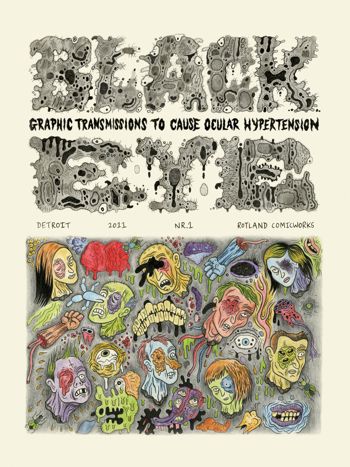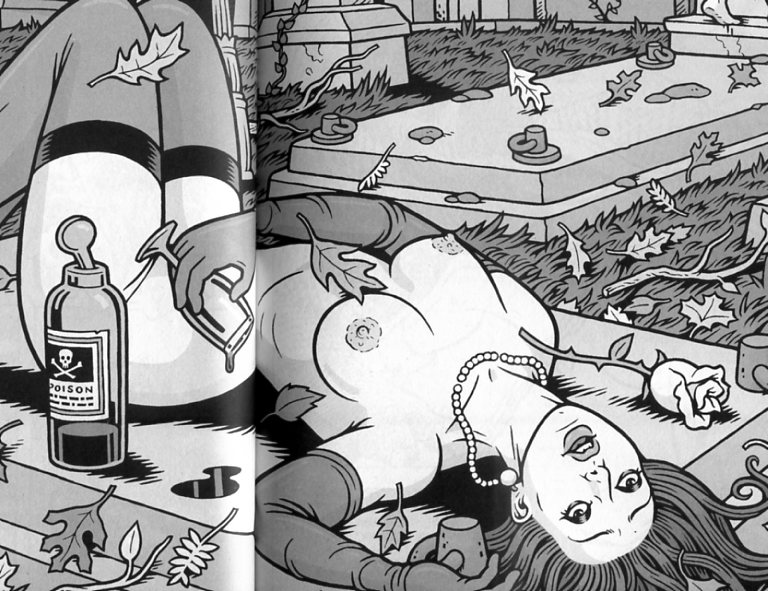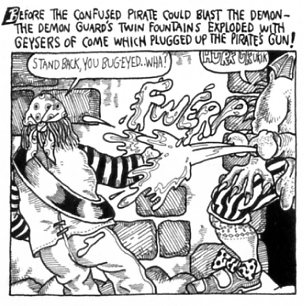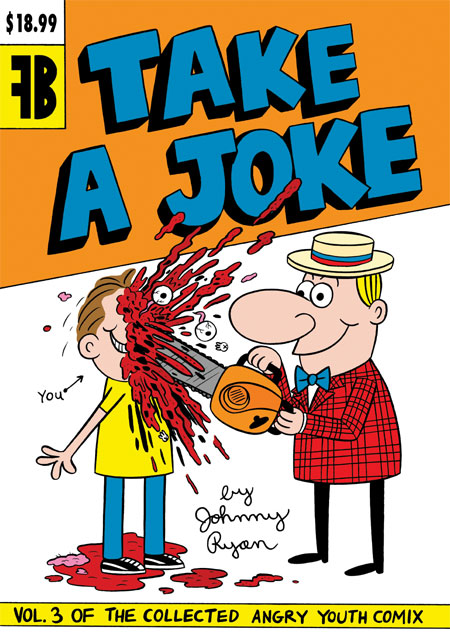Compare and Contrast Cage-Match to the Death: Joltin’ Johnny Ryan and PG “Wehrmacht” Wodehouse
Ten Rounds!
1. Both men are humourists (duh).*
2. Both have mainly made their living from serialising their work, a standard career-path for humourists in their respective times and markets.
3. Although known primarily for their work for adults, both artists have also produced work for children.
Wodehouse started his career writing allegedly comical stories about various misadventures at boys’ schools — specifically, the kind of not-quite-Eton public school that many of the characters in his later grown-up books would have attended, the kind of school where the upper-classmen have “fags” (younger students who perform menial domestic duties for them, like cooking and cleaning), where in summer the students care only about cricket (rugby in winter), where one student is always trying to cadge a fiver off another since he’s already spent his own allowance for the term betting Smythe that he couldn’t balance three copies of Liddell and Scott on his head while singing “I Do Like To Be Beside the Sea-Side”,** and where the Classics Masters have an imperious eye and brook none of the nonsense that inevitably arises. Wodehouse’s early work is for completists only and, even for them, it’s a struggle. He certainly hadn’t developed his wit in those early years; indeed, it would take more than another decade of writing grown-up humour for Wodehouse to start being even routinely amusing, let alone bust-a-gut LOL-worthy. As far as I know, he wrote specifically for children only at the start of his career; his juvenilia being thus being restricted to, well, his own juvenilia.
Ryan, on the other hand: if he’d written that last paragraph, he would have already made a dozen jokes about “fags” that would certainly not be considered suitable for the eyes of children, at least not by any reputable publisher. Nonetheless, Ryan has drawn gags for the now-defunct Nickelodeon Magazine (nearly every single issue, according to Wikipedia), MAD Magazine, and other kid-oriented outlets. It’s not as outlandishly unlikely as you might first think: just take out all the gags about the Holocaust, the KKK, AIDS, hookers — okay, so maybe it is a bit of stretch. But Ryan is first among his peers in plumbing the lower depths of scatological humour, and that sensibility translates well to kids’ humour. You just get rid of any jokes about “adult themes” like the Holocaust, and replace all the references to dicks and pussies and fucking and shit and piss and all that with references to boogers and farts and spew and, well, you’ve just designed yourself the perfect engine for making kids laugh, the very Platonic Form of What Makes Kids Laugh.
Which, I guess, in a way means that Socrates, having escaped from Plato’s Cave to contemplate the Forms themselves, was contemplating not just the Form of Beauty or the Form of the Good, but also the Form of A Unicorn Dressed in Farts Eating A Booger Pizza.
4. Both men work in a more or less blatantly unrealistic fantasy-world.
Wodehouse’s work is not overtly fantastic — there’s no unicorns riding around in Blandings Castle, not even a unicorn dressed in farts. But Wodehouse’s world is almost as far removed from reality: his characters have no more real connection to the greater world than the characters in Seinfeld. When the plot demands it, one character will have to work for a living, but only as the plot demands it. No one dies in Wodehouse, except offstage and generally some time in the past. Bertie Wooster, for instance, is an orphan but his parents appear to be long dead and of little concern to anyone. There are no serious problems for anyone, no real heartbreak or emotional turmoil or physical disability. When, in reading one of his many, many, many books, I came across a character who had not only served in the First World War but whose service was actually a plot-point, my monocle popped out and my wife clutched at her pearls — this sort of thing, essentially, does not happen in the world of Wodehouse. Even if we grant that Wodehouse’s world is, strictly speaking, a realistic one in the sense that there’s no magic qua magic, we can at least say that his world is not a naturalistic one.
Ryan’s world is much more overtly unrealistic, a world with very different physical laws than our own. Boobs Pooter shoots himself and becomes a ghost; he then invades the body of a woman, and fills her mouth with all-too-unghostly cum and then her breasts with shit. Aliens shoot tentacles down from the sky that enact hideous bodily transformations on humans. A missile-rocket visits a normal suburban family to demand a threeway with the pater and materfamilias — which he gets. A nurse makes a rope out of faeces, which she uses to swing around, hanging from the ceiling, like “Spiderman Woman”. Characters die in one strip to reappear in the next one along. Ryan’s world is the world of cartoons, where all the physical laws of our world always apply, except when it’s funnier for them not to.
Ryan, to be sure, does have some strips without Spiderman shit-rope, masturbating ghosts or even farting unicorns — strips which break no laws of nature; but even those tend to be non-naturalistic. For example, there’s a strip where Loady McGee tricks Sinus O’Gynus into thinking that the hot new look for the season is to glue a kid onto the end of your dick
— by the way, federales, please do not arrest me —
but, actually, Loady is just using a midget actor to trick Sinus. Now, nothing there violates the laws of physics, say, so it “could happen” (philosophers would say that it’s nomologically possible) — but, of course, even if the world could work like that, it doesn’t. I can’t think, offhand, of too many Ryan strips that feature people behaving “plausibly”, in a way that someone might actually behave in the real world. Certainly there are some: for instance a bit in the Jokepocalypse where one paramedic laughs at the other one for having hurt feelings, and the all-time classic 100% Anal Rape — where the whole gag is basically Ryan’s deadpan depiction of the victim’s post-event trauma — but this is more the exception than the rule. Ryan isn’t really interested in making a naturalistic or even realistic strip, not when there’s a (if not strictly unrealistic, then at least highly implausible) fart joke to be made.
5. Each has a very different sense of corporeality.
Wodehouse’s characters might as well not have bodies. They like their food, certainly — a particularly skilled chef plays an important role in several of the Wooster novels. And they occasionally get food poisoning, or sunburn, or a cold, or whatnot, and older secondary characters might complain about aches and pains, but only as the plot demands it. They certainly don’t need to shit, and they don’t need to piss, and above all they have no sexual activities whatsoever. Indeed, they appear to have no sexual desires at all, or even sexual organs for that matter. The idea of, say, Lord Emsworth jerking off is almost literally inconceivable. It is as though someone were to try to describe to you the letter “h” having sex with the number 57 — one feels that something must have gone seriously awry somewhere in his understanding, or his grasp of the English language; he has made a sort of category mistake.
Ryan, of course, would quite happily draw the letter “h” having sex with the number 57, but only if he could also draw Hitler licking the resultant creampie.
(Look it up, kids)
(Hey, speaking of not getting myself arrested: if there are any kids reading this, Jesus Christ, go tell your parents not to let you read this post)
6. Both men get a lot of humour from parodying the banality of their contemporary culture, contemporary narrative art in particular.
Wodehouse is nonspecific in his parody, his targets not so much individual artists and their work so much as general styles — the cliche of sentimental novels, mostly, but sometimes mystery novels or Hollywood gangster movies and the like.
Ryan goes personal; indeed, right for the personal jugular. He abridges Craig Thompson’s much-praised Blankets to three panels: boy meets girl, boy is reminded of “awesome piss-fight” with brother, boy breaks up with girl. [NB: this is actually a pretty accurate summary of the book]. Shitzo taunts Ivan Brunetti to just go ahead and kill himself already. Art Spiegelman’s father owns up that he was never in a concentration camp, and the numbers on his arm are just lotto numbers that have never been washed off. R. Crumb narrates a slideshow for his comics adaptation of The Book of Genesis: “uh…and here you see another drawing of Jews with big beards…wearing robes…” [NB: this is also a pretty accurate summary]; scientists fill a rocket with “liquid who gives a shit!” and blow up Crumb and his audience. And so on.
Cartoonists ribbing other cartoonists is nothing new, of course. Witness e.g. Wally Wood’s loving pastiche of newspaper strips in MAD, or Al Capp’s Dick Tracy parody, Fearless Fosdick. There’s probably some cave out there somewhere, as yet undiscovered by archaeology, where some neolithic cartoonist painted bison and hunters in way that totally zinged some other neolithic cartoonist’s painting of bison and hunters.
But Ryan’s parodies, potshots and piss-takes feel different from this. They’re cruel, vicious, bilious — and frequently very, very funny. Perhaps his most vicious swipe at his fellow cartoonists — that is, if you don’t count the already mentioned strip where he encourages the morbidly depressed Brunetti to follow through on the extended suicide note that was Schizo; or his unauthorized sequel to Paying For It, in which Chester Brown dresses up as a “whore” and is beaten, maimed and sexually assaulted, but still comes out of the experience thinking “OMG! Prostitution 4 Life!” — other than these most vicious swipes, and probably a couple of dozen other most vicious swipes, his most most vicious swipe is a strip called The Day The New Yorker Came to Town. In this strip, a take-down of the literary pretensions of art-comix-ers, Art Spiegelman cuts off his own nose to give the New Yorker a blowjob, R. Crumb sticks his adam’s apple up the New Yorker’s arse, Chris Ware gives the New Yorker a “tit-fuck” with his “brain-balls”, Seth (who, earlier in the strip, had pissed his pants at the prospect of a visit from the New Yorker) and Adrian Tomine snack on the New Yorker’s nuts, and poor old Ivan Brunetti, too ugly for the New Yorker, has to settle for sucking off a book of New Yorker dog cartoons.
Now that’s what I call comedy.
8. The main similarity between them is that they were incredibly prolific, with a similar, but not quite identical, effect on the quality of their work.
As it says in the bio at the start of so many of my copies of Wodehouse books, he wrote over 90 books in his life, as well as various plays and musical comedies. I’ve read somewhere between 50 and 60 of them (I’ve lost track, myself).
Ryan has produced hundreds upon hundreds of pages of comics. At times during the 00s, he was simultaneously drawing Blecky Yuckerella — a weekly strip for the “alternative press”, contributing gag cartoons to kids’ magazines, creating his own one-man anthology Angry Youth Comix, and churning out a one-page gag strip on the web each and every week. These last strips seem to have been entirely improvised; they’re often just one non-sequitur after another, as if the result of a game of exquisite corpse played by a gang of toilet-minded imbeciles with Tourette’s syndrome.
Because there’s so damned much of it, a lot of the art created by Johnny Ryan or PG Wodehouse is not very good. Much of it is hackwork. To be sure, due to Ryan’s peculiar sensibilities, his hackwork looks different from what other hacks might produce; but once you’ve seen a dozen vaginas spewing out leprechaun-turds covered in Holocaust-juice, you’ve seen them all. Much of Ryan’s and Wodehouse’s work is not worth reading at all, not even by connoisseurs and devotees.
But, both men, when they’re on, are among the funniest in their chosen medium. I came very close to including Take A Joke, the final collection of Ryan’s Angry Youth Comix (plus miscellanea), in my Top Ten for the Hooded Utilitarian poll — there’s an awful lot of jokes that miss in there, but Ryan has learned the valuable lesson that, if you throw enough of them out there, some of them are bound to hit. And when Ryan hits, he hits hard.
The difference between their prolificity (???) is that Wodehouse is much more consistent. Most of Wodehouse’s books from the mid-1920s on are pretty solid; even when a particular book isn’t hysterically funny, it can be relied on for a couple of amusing bons mots on every page. It’s mostly his early work that is consistently mediocre.
Ryan, on the other hand, is all over the shop. Take A Joke alternates between some of the best humour strips I’ve ever read — e.g. Home Early, The Day the New Yorker Came to Town, 100% Anal Rape, the ending to Graveyard Goofs — and lame button-pushing non sequiturs, like the multi-gag pages originally drawn for Vice.
9. Because they are so prolific, both artists exploit the combinatorial possibilities of rearrangements and variations over just a few basic elements. It would be easy enough to program a random generator to create “new” work by Ryan and Wodehouse by using a handful of variables.
For Wodehouse, the key elements are setting, plot and character. The setting will be [a country manor in a small English village or, much less often, a trans-Atlantic liner/a sea-side resort/New York]; the plot will involve one character who [wants to/doesn’t want to] marry another and who can only do this by stealing [a valuable antique/an incriminating manuscript/a pig], but in their way stands [a jealous suitor/an incognito detective/a rival thief/a hostile prospective father-in-law]; other characters will include [an imperious aunt/a nosy policeman/someone, anyone, in every book, in some kind of disguise/a mischievous but creative interloper who ultimately saves the day with an ingenious scheme].
For Ryan, the variables are: pudenda, impolite bodily functions, non-missionary sex acts, various hot-button topics (9/11, racism, rape…), and a banal or incongruous context. Just throw these together willy-nilly and you’ve got the premise for a Ryan strip, or a one-panel gag, or at least the ending to an improvised strip: a blind date who is half-man/half-shit! Hitler-piss, the only son of Christ! Erotic art-collecting squirrel! Captain America’s juicy pussy, better than Atlantis pussy! Joe Sacco interviewing his own balls about the smell of his farts! God’s giant cock shitting on Louis Riel! Harvey Pekar’s ball cancer running out on him because he and his “fucking friends and […] fucking comics are so boring that [ball cancer] just can’t take it any more!” [NB: this, too, is pretty accurate…] Luba’s haemorrhoid punching a Mexican in the face! A mountaineer riding an off-road tampon! The US President imposing a new tax on baby rim-jobs! A woman so turned on by a passer-by in a shit-wig that she begs him to “do [her] in the butt right now, right here on the sidewalk!!”, but the guy has to go glue his dick back on, at Ye Olde Dick-Glue Shoppe! A giant statue of The Cleveland Steamer! ” Sweet Chubby” Cheeks and Li’l Bloody’s Silly Putty, “made from 100% real homosexual corpse scrotums! So you know it’s good!” A woman indignantly defending her right to breastfeed her beaver as “the most beautiful & natural thing a woman can do!” Martians that love nigger shit, faggot ass and gook splooge (which turn out to be Martian words for, respectively, ice cream, nuts and hot fudge)! Sherlock McRape investigating the strange case of a woman hit in the belly by a jar of jelly while watching Hitler’s robonic testicloids on the TV news! A man on a pogo stick bouncing from vagina to vagina! An “awesome new game” called “Mommy, my faggot has diarrhea!” A Ku-Klux-Klansman stripper jumping out of a wedding cake at a KKK wedding! A man who wakes up married to Retarded Hitler, who in turn goes nuts when offered grape juice because, naturally, he wants to “Exterminate the juice!”. The award ceremony for the 2005 COBBY Funniest Baby-Boner-in-the-Ear Gag of the Year Award! Hopey Glass strumming on Maggie Chascarillo’s electric asshole with her tongue!
You get the picture.
Using a simple structure to generate indefinitely many gags is one thing Wodehouse and Ryan also have in common with another highly-prolific humourist: John Stanley. Stanley created or co-created several thousand pages of Little Lulu and Tubby strips, not to mention hundreds of pages of other comics, and he too worked a million variations off a few basic themes: Lulu tries to join the boys’ gang, Lulu outsmarts Tubby with a dose of his own medicine, Lulu tells Alvin a story about that ol’ Witch Hazel, Tubby tries to impress Gloria and outdo Wilbur van Snobbe… If you want to churn out comedy by the barrel, this is evidently the way to do it.
10. PG Wodehouse is the pinnacle of English-language comedy — his musical dialogue, precision-tuned farce, and above all his inversions and manipulations and play with language and cliche.
But Wodehouse never drew a parody of Marvel Super-Villain Team-Up starring the Red Skull and Art Spiegelman. Advantage: Johnny Ryan.
***
Final Score: Tie
* For this piece, I’ve passed over Ryan’s more recent work, in which he often turns away from humour into straightforward horror or action. To talk about that material would be another post altogether.
** Self-indulgent autobiographical note: the only thing I got out of reading Bryan Talbot’s excruciatingly boring Alice in Sunderland was learning that the Liddell of Liddell and Scott, that faithful companion of my youth, was the father of Alice Liddell aka Alice in Wonderland. Small world.
Image attribution:
Boobs Pooter sketch, Johnny Ryan at Comic Art Collective
Photo of Ian Carmichael as Bertie Wooster, at Hot Guys in Period Costume






